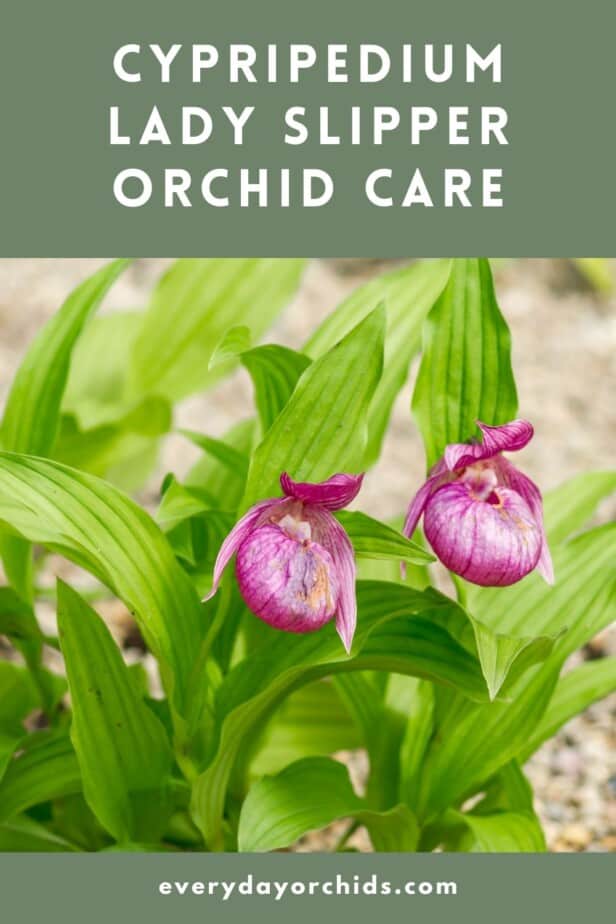Cypripedium orchids as also known as “Lady Slipper” orchids. These beautiful, showy orchids are sometimes referred to as a “Lady Slipper.” This is because the bottom petals come together to form a pouch that resembles a lady’s slipper.
Are you wondering if you could also grow these Lady Slipper orchids in your garden and care for them? The answer is, yes, you absolutely can. You just need to know the basic growing requirements for these orchids, which I will outline below.
Cypripedium, or Lady Slipper, orchids, are hardy terrestrial orchids and are not difficult to grow. These low light orchids grow in shade to partial shade. They can survive in colder climates and often bloom in early to late spring. Water your Lady Slipper orchid once you notice that the potting media is dry. Fertilize once every other week at most. Use loose, well-draining, rich loamy soil when planting your orchid.

When planting your Cypripedium orchid in your garden, you want to mimic their native conditions as much as possible. In this article, you will learn how to successfully care for your Cypripedium Lady Slipper orchid. Keep reading to learn more!
Please note that these links are affiliate links and as an Amazon Associate, I earn from qualifying purchases. Purchases made through affiliate links in this post may generate commissions at no additional cost to you. Use this link for a discounted Amazon Prime trial. Thank you for your support!
Table of Contents
What are Lady Slipper Orchids?
There are thousands of orchid species and varieties in the world and they are divided into subfamilies. Within the family of orchids, there is a subfamily known as Cypripedioideae. This subfamily Cypripedioideae includes the genera of Cypripedium, Mexipedium, Paphiopedilum, Phragmipedium and Selenipedium. These different genera of orchids include numerous species of Lady Slipper orchids.
Here, I will focus on the Lady Slipper orchids that are part of the orchid genus Cypripedium. This orchid genus alone includes over 50 different orchid species! In a future article, I will talk about Paphiopedilum lady slipper orchids, which are also very popular.
Throughout this article, I will use the term Cypripedium orchid and Lady Slipper orchid interchangably. Please be aware that I am referring to the Lady Slipper orchids within the Cypripedium subfamily of orchids.
Cypripedium orchids are considered terrestrial orchids, which are ground orchids. There are also a number of Cypripedium hybrids available. Chances are high that you will be able to find a Lady Slipper orchid to suit your climate and region.
Where Can You Find Lady Slipper Orchids?

In the wild, these orchids are found in forests and woodland areas. In fact, many of the national forests across the United States have Cypripedium orchids growing wild in the forests, grasslands and meadows.
If you ever come across these beautiful orchids while hiking or exploring our national parks, please know that it is illegal to dig up or pick the orchids from federal lands. In addition, orchids dug up from the wild rarely survive the transplantation into a pot or home garden. The stress and abrupt change in environment is just too much for them. If you ever see these orchids in the wild, just admire them, take a picture and move on.
All About the Blooms
Cypripedium orchids typically bloom from the late spring to end of summer. The blooms last only 1 to 3 weeks before they die.
Each flower spike will have anywhere from 1 to 3 blooms. While the number of blooms are not impressive, the blooms themselves are. The flowers are showy and large, with several flat white oval petals and a colorful pink, red, or magenta “pouch.” This pouch is what mimics the appearance of a “lady’s slipper.”
This unique shape of the flower petals helps the orchid attract pollinators, such as bees and flies. Successful pollination, however, is pretty rare.
The leaves of the Cypripedium orchid are wide, ribbed or striped. They are flat, leathery, and have a deep green color. The orchid plant can be anywhere from 1 to 2.5 feet tall. The size and beauty of this orchid makes it an ideal flower to line your garden bed.
How to Care for Lady Slipper Orchids

Many orchids are tropical orchids that require warmer temperatures and growing conditions. Not so with Lady Slipper orchids. Cypripedium orchids are known for being hardy orchids, well suited for colder temperatures and shaded areas. Let’s talk more about the growing requirements for Cypripedium Lady Slipper orchids below.
Temperature Tolerance
This popular orchid favors cold temperatures and can survive in USDA Zones 2 to 5 and the cooler areas of Zone 6. This covers much of the northern United States, including the Northeastern and Mid Western states.
Due to the cold-hardy nature of this orchid, the Cypripedium orchid is a great option for those living in colder climates where it snows during the winter. Some Cypripedium orchid varieties can even be found growing in Siberia and Alaska!
Lighting and Environment
Cypripedium Lady Slipper orchids are low light orchids. They favor shade to partial shade. This is similar to lighting conditions in the forests or woodlands. When choosing a location to plant your orchid, make sure that your orchid will get filtered light and has adequate shade.
Planting your orchid under trees would achieve this. The canopy of leaves will provide shade and filtered light mimicking that of a forest. If you don’t have a lot of shade trees around, you can also buy a sun shade or a canopy to provide outdoor shade for your orchids.
Potting and Soil Requirements

When planting your Lady Slipper orchid, make sure you use a well-draining soil that is evenly moist and rich in humus. Ideally, the soil should have an acidic or low to neutral pH.
Poor soil conditions are one of the biggest reasons why orchid growers do not have success with growing Cypripedium orchids. Therefore, pay close attention to the potting media when you are planting your orchid.
In the wild, the roots of the Cypripedium orchid spread out along the surface of the soil around the plant. In other words, the roots grow out laterally to the sides of the orchid, rather than straight down. Keep this in mind as you plant your orchid at home. Don’t dig a deep hole for your Cypripedium orchid and cover the roots with soil as you might do with other plants.
Instead, choose a shaded or partially shaded area of your garden for your orchid. Prepare the soil and humus, then position your orchid in place. Spread the roots out around the orchid, then cover the roots with humus and mulch. Make sure you water regularly to keep the soil moist until the orchid roots become established.
Watering and Fertilization Needs
Maintaining adequate humidity levels are essential. Lady Slipper orchids require at least 50% humidity levels in order to thrive. You can monitor this using a hygrometer.
If you need to increase humidity around your Cypripedium orchid, there are several options available. You can use a humidity tray, a cool-mist humidifier, or regularly mist your orchid plant. If you keep your Cypripedium orchid outdoors, you can use an outdoor water feature such as a water fountain or a pond to increase the area’s humidity levels.
When watering your Cypripedium orchid, thoroughly soak the soil or potting mix each time. Let it dry out before the next watering.
Fertilize using an orchid fertilizer about twice a month, or once every two weeks during the growing season. During the winter months, when the orchid is dormant, you do not need to fertilize.
Toxicity and Things to Know
As to whether orchids are poisonous or not, Cypripedium orchids do have a mild toxicity rating. This is good to be aware of if you have a pet or even a very young child in the house.
If that pet or young child has a tendency to put things in their mouth or chew on your plants, then you may want to choose a different orchid for your home. This orchid can cause mild skin irritation if touched. It can also cause irritation to the mucous membranes in the mouth if eaten.
Final Thoughts
Cypripedium orchids are beautiful and unique, with their large colorful blooms and petal pouch. There is a wide variety of Lady Slipper orchids available with varied temperature tolerance ranges and growing conditions. You should be able to find one to fit your growing environment.
Before selecting a Cypripedium orchid for your garden, make sure it will be able to survive in your USDA temperature zone. You will also need to have the proper soil and lighting conditions available. This will help ensure success in growing your Cypripedium Lady Slipper orchid.
If you enjoyed this article, please pin it and share!





